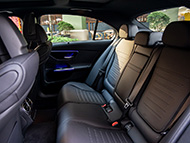By Lee Pang Seng
MERCEDES-BENZ took the initial step of going ‘electric’ with the C 200 that was launched two years ago featuring a second-generation integrated starter-generator (ISG) to qualify as a mild hyrbid. It uses a 48-volt electrical system for ‘intelligent assistance’ at low engine speeds that includes boosting or energy recovery to make ‘significant’ fuel savings possible.
The four-cylinder engine with the ISG that enjoys an additional output of 15kW (20.4hp) and 200Nm made its premiere in this C-Class generation (W206). To complete the package, Mercedes-Benz says the 9G-Tronic automatic transmission was also developed further to complement the ISG functions.
Well, Mercedes-Benz has decided to move from mild hybrid to full hybrid, at least for the higher displacement C 300 (2.0-litre), in the C 350 e Plug-in Hybrid. Mercedes-Benz sees this as a ‘bridge towards an all-electric future’ and to pave the way for other plug-in hybrid models to come.
The change is significant as the C 350 e Plug-in Hybrid comes with an electric motor to augment the internal combustion engine; it has a rated output of 95kW (129hp) and a whopping 440Nm that clearly reflects the advantage of electric power. This is supported by a bigger higher-voltage battery (located beneath the boot floor) with an energy content of 25.4kWh to provide ‘substantial’ electric range.
In that respect, Mercedes-Benz says the C 350 e Plug-in Hybrid has an all-electric range of up to 117 kilometres (WLTP – Worldwide Harmonised Light Vehicle Test Procedure) that’s good for city driving without burning too much fuel and saving the environment with less emission.
The 2.0-litre engine, however, comes with a lower output compared to the unit in the C 300 that the Plug-in Hybrid replaces. It is about on par with the 1.5-litre turbo engine in the C 200 with 150kW (204hp) at 6100rpm but more torque of 320Nm from 2000 to 4000rpm. What matters more is the combined output of the engine and electric motor – 230kW (313hp) and a peak torque of 550Nm.
How does that translate to performance? A comparison between the C 350 e Plug-in Hybrid and C 300 shows a pretty similar pace; 0-100km/h in 6.1 seconds (C 300 6.0 seconds) and 245km/h top speed (250km/h). The combined fuel consumption for the Plug-in Hybrid is 7.7 L/100km (almost 13km per litre) against the C 300’s 7.0-6.6 L/100km (14.3 to 15.1km per litre).
The fuel consumption aspect is best enjoyed in city driving with the high electric range available, which is a typical advantage of EVs (electric vehicles) or hybrids running on electric power. This is because the C 350 e comes with an energy recovery function as expected. This system allows kinetic energy to be recuperated during deceleration or downhill driving. Mercedes-Benz says the energy recovery output is now above 100kW.
The driver could also choose the energy recovery rate that is available in three stages via rocker switches behind the steering wheel. This is possible in all driving modes except Sport. In driving mode D, there is the choice of ‘one-pedal feeling’. With this stage, the car slows down by electric means when taking the foot off the accelerator pedal to the point of not having to step on the brake pedal (we experienced such a mode in the Nissan Leaf EV some years ago and were impressed with the function).
Being a plug-in hybrid, the C 350 e is a heavier car against the C 300 due to the bigger battery. It tips the scales at 2105kg kerb weight against 1675kg for the latter. The high voltage battery is backed by a six-year or 100,000km warranty that should give some peace-of-mind ownership and driving.
To counter the heavier rear end of the car, due to the location of the high-voltage battery, the C 350 e comes standard with a self-levelling air suspension for the rear axle. This gives the Plug-in Hybrid variant the honour of being the only C-Class to have such a suspension system. The independent front remains with steel springs and dampers.
Adding a sporting appeal to the C 350 e, the Plug-in Hybrid is presented with an AMG Line exterior with Night Package. This is reflected in the 18-inch AMG five-spoke light alloy wheels while the latter features ‘sporty, expressive design elements in high-gloss black such as the louvre of the radiator shell, trim moulding in the AMG front apron, beltline trim strip and window surround, and exterior mirror housings’.
The AMG Line interior sees metal structure trim elements, multifunction sports steering wheel in nappa leather and AMG floor mats. This complements the standard trims of Artico man-made leather upholstery in black and instrument panel and beltlines in Artico man-made leather in nappa.
Like the C 300, the C 350 e Plug-in Hybrid is locally assembled at the Mercedes-Benz production facility in Pekan, Pahang. At the time of its launch, the C 350 e price was not fully concluded but it is expected to be in the region of RM355,000.
The Mercedes-Benz C-Class at a glance:
Model |
Mercedes-Benz C 350 e |
Displacement (cc) |
1,999 |
Rated Output (kW[hp]/rpm) |
150 [204]/6,100 |
Rated Torque (Nm/rpm) |
320/2,000 – 4,000 |
Rated Output for Electric Motor (kW) |
95 |
Rated Torque for Electric Motor (Nm) |
440 |
Max. rated power system output (kW/hp) |
230/313 |
Max. torque at rated power system output (Nm) |
550 |
HV battery - energy content installed (kWh) |
25.4 |
Acceleration 0-100 km/h (sec) |
6.1 |
Top speed (km/h) |
245 |
Kerb weight/payload (kg) |
2,105/510 |
Fuel consumption, combined (l/100km) |
7.7 |
Combined CO₂ emissions (g/km) |
17 - 12 |
Recommended Retail Price* with 10% Sales Tax |
Estimated from RM 355,000 |
*On the road without Insurance
























